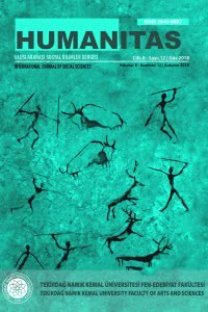Elektra Mitinin Tekrar Yaratılmasında Eshilos, Sophokles, Euripides ve Menelaos: Sanatlararası Bir Diyalog
Bu çalışma, Eshilos’un Adak Sunucuları, Sophokles’in Elektra ve Euripides’in Elektra adlı oyunları başta olmak üzere, milattan önce beşinci yüzyılda yer alan Atina dramalarında ön plana çıkan trajik kahraman Elektra’ya odaklanmaktadır. Bu gizemli figür varlığını sadece edebi metinlerde değil görsel sanatlar ve müzik alanında da unutulmaz kılacak şekilde sanatçıların hayal gücünü etkilemeye devam etmektedir. Bu çalışma, asla çağdışı olmayan Elektra mitinin özelliklerini vurgulayarak söz konusu mitin çeşitli sanatçılar için hangi yollarla ilham kaynağı olduğunu ortaya koymaya çalışmaktadır. Bunun yanı sıra, mermer sertliğinde şekillendirilmiş Elektra figürünün bile adalet arayışıyla birlikte dini, ahlaki ve sosyal değerlerin yeniden tesisi çabalarında hem acıma hem de hayranlık duygusu uyandırmaya devam ettiği gözlemlenmektedir.
Anahtar Kelimeler:
Elektra miti, antik trajedi, güzel sanatlar, Elektra ve Orestes mermer heykelleri
Aeschylus, Sophocles, Euripides and Menelaos Shaping the Significance of Electra Myth: A Dialogue Between Arts
The present study focuses on the tragic heroine, Electra, who rose to prominence in the Athenian dramas of the fifth-century BC, particularly in Aeschylus’s Choephori, Sophocles’s Electra and Euripides’s Electra, but this enigmatic figure continued to stir the imagination of the artists of the subsequent generations to the extent of making its presence memorable not only in literary texts but also in visual arts and music. This paper attempts to reveal the ways in which Electra myth has delighted and inspired various artists by stressing out the peculiarities of this myth that never seems to go out of fashion. It can also be observed that Electra’s figure, even sculpted in marble severity, continues to arouse both pity and admiration in her quest and demand for justice as well as her attempts to re-establish the religious, moral and societal values.
___
- Aechylus. (1977). Oresteia (R. Fagles, Trans.). London: Penguin Books.
- Dabezies, A. (1992). Fromprimitive myths to literary myths. In P. Brunel (Ed.), Companion to literary myths, heroes and archetypes (pp. 960-967). London: Routledge.
- Fejfer, J. (2008). Roman portraits in context Vol. 2. New York: Walter de Gruyter.
- Frog,M. (2015). Mythology in cultural practice: A methodological framework for historical analysis. RMN Newsletter,10, 33-57.
- Hawley, R. (1997). The dynamics of beauty in classical Greece. In D. Montserrat (Ed.), Changing bodies, changing meanings: Studies on the human body in Antiquity (pp. 37-54). London: Routledge.
- Girard, R. (1979). Violence and the sacred. London: John Hopkins University press.
- Golban, T. (2004). Ancient and modern hypostases of Electra myth. Dumlupinar Universitesi Sosyal Bilimler Dergisi,11, 41-52.
- Golban, T. (2006). Electra myth – The myth of inter-human determinism. Dumlupinar Universitesi Sosyal Bilimler Dergisi,15, 181-190.
- Golban, P. (2018). A History of the Bildungsroman: From Ancient Beginnings to Romanticism. Newcastle upon Tyne: Cambridge Scholars Publishing.
- Luschnig, C. E. (2015). Electra. In Brill’s companion to the reception of Euripides (pp. 90-103). Boston: Brill Publishing.
- Manca, J., Manca, J., Bade, P. & Costello, S. (2014). 1000 sculptures of genius. New York: Parkstone International Press.
- Serra, J. P. (2015). Electra, the voice of Hades. In A. R. Fernandes (Ed.), The power of form: Recycling myths (pp 90-103). London: Cambridge Scholars Publisher.
- Shaya, J. (2013). The public life of monuments: The SummiViri of the Forum of Augustus. American Journal of Archaeology,117(1), 83-110.
- Sophocles. (2001). Electra. New York: Oxford University Press.
- Squire, M. (2019). The art of the body: Antiquity and its legacy. Oxford: Oxford University Press.
- Taplin, O. (2007). Pots and plays. Interactions between Tragedy and Greek Vase-painting of the fourth century BC. Los Angeles: The J. Paul Getty Museum.
- Vlahogiannis, N. (1997). Disabling bodies. In D. Montserrat (Ed.), Changing bodies, changing meanings: Studies on the human body in Antiquity (pp. 13- 36). London: Routledge.
- ISSN: 2147-088X
- Yayın Aralığı: Yılda 2 Sayı
- Başlangıç: 2013
- Yayıncı: Namık Kemal Üniversitesi
Sayıdaki Diğer Makaleler
Satranç: Doğu Medeniyetinin Batı'ya Bir Hediyesi
Kurumlar Sosyolojisi Perspektifinden Pandemi Döneminde Kurumsallaşma Pratikleri
Satranç: Doğu Medeniyetinin Batı'ya Bir Hediyesi
Yazar – Kahraman İlişkisi Bağlamında, Kahramanda Yazarı Görmek: Dertli Dolap
Dorian Gray'in Portresinin Uyarıcı Hikayesi: Kıssa ve Otobiyografi
İnsanın Zaman Deneyiminin Fizyolojik ve Psikolojik Temelleri
Histeri, Delilik ve Disiplin Edici Güç: The Next Room ve Mrs. Packard
Başka Bir Modernlik Hâli: Fikret Adil’in Eserlerinde İstanbul’un Bohem Hayatı
